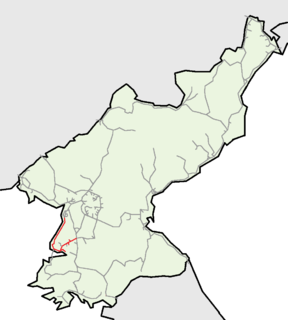
Ch'ŏllima is a kuyŏk in Namp'o Special City, North Korea. Prior to 2004, it was Ch'ŏllima-kuyok, a district of northeastern Namp'o Directly Governed City. Following the demotion of Namp'o in 2004, Ch'ŏllima became an independent county. The region was part of Kangsŏ county in 1952, and was entered into Taean city; when Taean was demoted to county in 1983, it became part of Namp'o Special City.

Kangsŏ is a district in Namp'o Special City, South P'yŏngan province, North Korea. The population is 100,000.

The P'yŏngnam Line is an electrified standard-gauge trunk line of the Korean State Railway in North Korea, linking P'yŏngyang with the port city of Namp'o and the hot springs at P'yŏngnam Onch'ŏn. The length of the line is 89.9 km (55.9 mi).
Kangsŏ Station is a railway station in Kiyang-dong, Kangsŏ-guyŏk, Namp'o Special City, North Korea, on the P'yŏngnam Line of the Korean State Railway. It is the starting point of the Taean Line and of the Posan Line.

The P'yŏngdŏk Line is an electrified standard-gauge trunk line of the Korean State Railway in North Korea running from Taedonggang Station in P'yŏngyang, where it connects to the P'yŏngbu, P'yŏngnam, P'yŏngra and P'yŏngŭi Lines, to Kujang, where it connects to the Manp'o and Ch'ŏngnyŏn P'arwŏn Lines. The total length of the line is 192.3 km (119.5 mi).
Kangsŏn Station is a major railway station used by passenger and freight trains in Kangch'ŏl-dong, Ch'ŏllima-guyŏk, Namp'o Special City, North Korea, on the P'yŏngnam Line of the Korean State Railway. It is also the starting point of the freight-only Chamjilli Line.
Chamjilli Station is a railway station in Chamjil-li, Kangsŏ-guyŏk, Namp'o Special City, North Korea. It is the terminus of a branchline from Kangsŏn on the P'yŏngnam Line of the Korean State Railway.
Posan Station is a freight-only railway station in Posan-dong, Ch'ŏllima-guyŏk, Namp'o Special City, North Korea. It is the terminus of the Posan Line from Kangsŏ on the P'yŏngnam Line of the Korean State Railway.
Sinnamp'o Station is a freight-only railway station in Hanggu-guyŏk, Namp'o Special City, North Korea, on the P'yŏngnam Line of the Korean State Railway; it is also the starting point of the Namp'ohang Line.
Namp'o Station is a railway station in Hanggu-guyŏk, Namp'o Special City, North Korea on the P'yŏngnam Line of the Korean State Railway, as well as the starting point of the Tojiri Line. There is an engine house northwest of the station in Munhwa-dong, Hanggu-guyŏk.
The Kŭmsŏng Tractor Factory, located in Kiyang-dong, Kangsŏ-guyŏk, Namp'o, is North Korea's largest manufacturer of tractors, bulldozers, and other agricultural equipment. Employing around 10,000 workers, the factory has a floor area of 142,000 m2 (1,530,000 sq ft) on a total area of 400,000 m2 (4,300,000 sq ft). Peak production capacity is 10,000 tractors per year. The factory's current products include the Ch'ŏllima 28 28 hp (21 kW), Ch'ŏllima 32 32 hp (24 kW), Ch'ŏllima 40 40 hp (30 kW), P'ungnyŏn 75 75 hp (56 kW), Sonyŏn 45 hp (34 kW) and Ch'ŏllima 2000 tractors, and the P'ungnyŏn bulldozer. As of 2017, the factory was producing the new 80-hp Ch'ŏllima 804 tractor model. Claims have been made this factory also produces TEL mobile missile platforms.
The Namp'o Smelting Complex is a smelter in Hadaedu-dong, Hanggu-guyŏk, Namp'o Special City, North Korea.Employing over 700 workers, it is a comprehensive nonferrous metal production facility including smelters for gold, copper and zinc, other metal rolling and alloy production, smelting by-products, and chemical fertiliser production. Annual production capacity is 15,000 tons of blister copper, 5,500 tons of refined copper, 7,000 tons of copper wire, 28,000 tons of zinc, and 5,000 tons of lime fertiliser. Concentrates and ores are received from the mines at Taedae-ri and Suan.
The Namp'o Shipyard Complex, located in Haean-dong, Hanggu-guyŏk, Namp'o, is one of North Korea's primary shipbuilding enterprises, building primarily cargo ships and fishing boats. Employing 7,000 workers, the facilities include drydocks, 19 cranes, various cutting machines and a 6,000 ton floating dock. Ships of up to 20,000 tons displacement can be built. Current production includes cargo ships of 14,000 and 20,000 tons, 1,500-ton destroyers and 82-ton patrol boats for the Korean People's Navy, dredgers, 3,750-ton stern trawlers, etc.
The Namp'o Kangsŏ Missile Factory is a factory reportedly manufacturing the Scud and Taepodong-2 ballistic missiles, located in Kangsŏ-guyŏk, Namp'o, North Korea The factory is located partially above ground and partially underground and is rail-served, with a spur entering the underground facility from the Chamjilli railway station on the P'yŏngnam Line of the Korean State Railway. The plant has reportedly produced up to 200 Scud missiles annually, using electronic components based on Japanese designs manufactured at the P'yŏngyang Semiconductor Factory.
The Taean Friendship Glass Factory, located in Choje-ri, Taean-guyŏk, Namp'o, North Korea, is a factory producing plate glass and other glass products.
Taean Hwamul Station is a freight-only railway station located in Sep'o-ri, Taean-guyŏk, Namp'o-t'ŭkpyŏlsi, North Korea; it is the terminus station of the Taean Line of the Korean State Railway.
The Posan Line is an electrified freight-only railway line of the Korean State Railway in South P'yŏngan Province, North Korea from Kangsŏ at the junction of the P'yŏngnam and Taean Lines, to Posan.
The Chamjilli Line is a non-electrified freight-only railway line of the Korean State Railway in South P'yŏngan Province, North Korea from Kangsŏn on the P'yŏngnam Line to Chamjilli.










